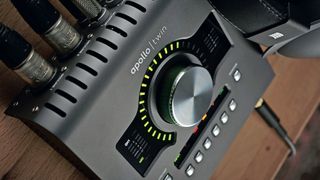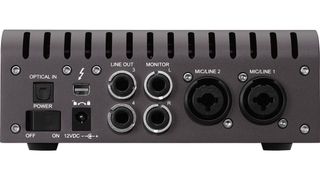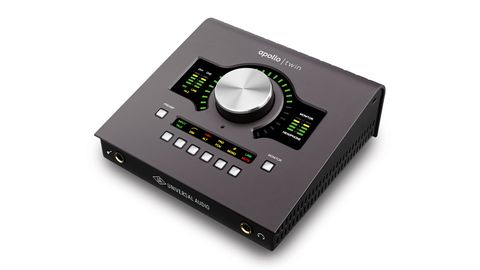A scaled-down alternative to Universal Audio’s flagship Apollo 8 and 16, the original Apollo Twin has been giving ‘the rest of us’ access to those mythical Unison preamps, first-class I/O and swanky UAD plugins for three years now.
The new Apollo Twin MkII is essentially more of the same, but with a few minor improvements, and an optional DSP upgrade. Let’s start with what’s stayed the same.
Still a desktop-format 2-in/-6-out audio interface with 24-bit/192kHz capabilities, the Apollo Twin MkII would be almost indistinguishable from the original were it not now black rather than silver. It connects to your Mac or PC via Thunderbolt, but it has to be powered from the wall; and while the original Twin (still available) could be had in a USB 3 version, it’s not clear whether the MkII will follow suit.
The back panel and front edge house two combi Mic/Line inputs, a Hi-Z quarter-inch guitar input (overriding Mic/Line 1 when occupied), four quarter-inch output jacks (two Monitor, two Line), stereo S/PDIF out, Headphones out and a TOSLINK port for adding up to eight analogue inputs via ADAT.
The top panel centres on a satisfyingly oversized knob, controlling Monitor or Preamp input levels, as selected with the two buttons flanking it; and six Option buttons, contextualised by an LED icon strip, that again change function depending on whether the unit is in Monitor or Preamp mode. Input and output metering are provided by four five-segment LED ladders.

In Unison
Also a ‘DSP box’ for powering UAD plugin effects (VST/AU/AAX/RTAS), the Apollo Twin MkII features the same game-changing Unison preamps as its predecessor, fed by the Mic/Line and Hi-Z ins. These enable a gradually expanding subset of UA’s classic hardware emulation plugins to be inserted directly into each input path, physically reconfiguring the preamp’s impedance and gain staging - prior to the regular algorithmic modelling of valves, transistors, amps, EQ, etc - for near-zero-latency monitoring and/or recording through them.
In a nutshell, it’s like singing into a real preamp, or playing guitar through a real distortion pedal, with no perceptible delay between input and output. Direct monitoring with plugins, in other words.
When we first reviewed the Twin, there were only three Unison plugins available - the UA 610-B (bundled), the UA 610-A and the API Vision. Since then, they’ve been joined by the Manley Voxbox, Neve 1073 and 88RS; eight guitar and bass amps by Ampeg, Fender and Marshall; and three distortion stompboxes, including the bundled Pro Co Rat emulation, Raw. All of them sound and feel great, and Unison remains a huge and unique selling point for the Apollo Twin MkII.

As for the rest of the UAD plugins bundled with the Apollo Twin MkII, you still get the Realtime Analog Classics collection, comprising 14 compressors, EQs, amp sims, distortions and reverbs, including the more-than-serviceable Legacy versions of the 1176, LA-2A and EQP-1A, the acclaimed RealVerb Pro, and a lite version of Softube’s Amp Room Bundle. Many, many more are available through the UAD store, ranging in price from £75 to £299, and since they’re all installed with the UAD software (weighing in at about 2GB) whether you like it or not, you can activate the two-week demo of each at your leisure.
Twins, Basil, Twins!
So, apart from the colour change, what else is new? Well, UA has apparently beefed up the AD/DA converters, for even more dynamic range and less distortion, but the MkI was so outstanding in this department that you’ll be hard pushed to tell the difference - it’s still the cleanest, most transparent-sounding interface in its price range.
All members of the Apollo family are configured and handled using the excellent Console software application, which looks like a mixing desk with up to 14 Input channel strips (four of them ‘Virtual’ ones, visible as hardware outputs in your DAW), two auxiliary effects channels, and Control Room section and Monitor sections. As well as the auxiliary buses and main Monitor bus, signals can be routed to Line outs 3/4 and the Headphones bus for discrete cue mixing.
Each of the two Analog Inputs has a Unison insert point, and every channel, including the Talkback mic, can host up to four regular UAD effects plugins, making Console a useful standalone mixer. The plugins browser that pops up when an insert point is clicked shows the entire UAD range by default, with no discrimination between those you own and those you don’t, and although you can ‘Hide’ the latter in the Console Settings, it feels like there should be an option to just filter them all in and out in the browser itself - there are a lot of them, after all. That aside, seamlessly designed, utterly rock solid and very easy to use, Console is as high-quality as audio interface control/mixer apps get.
More dramatically, the MkII has been granted a massive boost to the onboard DSPs. The original Twin maxed out at the two-core Duo version, but the MkII can be had in Solo, Duo and Quad editions, each doubling the power and, consequently, UAD plugin counts of the one below. So, whereas the Duo can handle 18 stereo instances of the Pultec EQP-1A Legacy, for example, before conking out, the Quad manages hosts up to 36 of the buggers.

Other than that, the MkII sees a refinement of its studio workflow with the addition of a talkback mic and front panel access to a few of the monitoring functions of the Console software (see It’s not just the hardware).
In Monitor mode, four of the Option buttons - which weren’t used at all by MkI - now come into play, necessitating the addition of a new row of icons to the LED strip, which has been made a bit deeper to accommodate them.
The Talk button activates the talkback mic (the tiny hole below the knob), which can be sent to the outputs of your choice for control room communication or quick recording of notes and cues. The Dim button lowers the monitor output level, the Mute switch kills it entirely, and the Mono button switches between stereo and mono output for playback system compatibility checking. Very nice.
Finally, the Alt and FCN buttons are linked to Console’s monitor switching and ‘cascaded’ (up to four Apollos can be linked) routing options, respectively.
Apollo’s creed Apart from the Quad Core option, the Apollo Twin MkII is the very definition of an iterative upgrade. If you’re already a happy owner of MkI, the talkback mic and extra monitoring control alone aren’t reasons enough to reinvest. If, however, you’ve been hankering for more DSP than your existing Twin affords you, your day has come - have at it. And, of course, newcomers to the world of Apollo and UAD now get even more for their money, which can only be a good thing.
Given how much we loved the original Apollo Twin, it’ll come as no surprise that the MkII again wins our highest possible recommendation. Far, far more than possibly the best audio interface ever made, this is a musically empowering hardware/software hybrid, capable of elevating even the humblest of home and project studios to genuinely professional-quality heights.
- Explore more of the best guitar audio interface options


